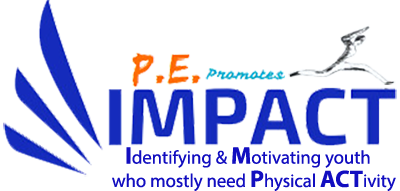About PE Project
Identification and Motivation of youth who mostly need Physical ACTivity
According to World health Organization, children and adolescents need at least 60 minutes of vigorous-to-moderate intensity physical activity daily. Many pupils are well beyond this standard, a condition that characterizes them as inactive and unhealthy. To activate these pupils we must firstly find them and then motivate them to become physically active.
School Physical Education (PE) is the only setting allowing the diagnosis of physical inactivity and the implementation of inclusive strategies for youth who mostly need Physical Activity (PA) and sport involvement.
Still, there are no concerted actions from policy makers to identify vulnerable pupils and schools with high levels of inactivity and to develop effective policies for promoting PA in these groups. This project addresses this need through the development of tools and recommendations for the Identification and Motivation of inactive youth who mostly need Physical ACTivity (IMPACT), including an Example of Good Practice. The present tools allow all interested stakeholders, and particularly educational, sport and local authorities, to have instant, updated online information about levels of inactivity across schools and across poor pupils and migrants within these schools, and the main barriers that hinder PA.
The IMPACT consortium contributed successfully to the training of PE teachers in how to use these tools in the diagnosis of physically inactive youth. We also developed educational material and tools that can be integrated with PE curricular and facilitate the training of PE teachers and multipliers on how to use this material to motivate inactive pupils and promote their sport and PA involvement. Tools and materials were developed in 7 European languages plus a tool in Arabic. Data were selected across 6 countries and an intervention including 5 webinars took place across 4 countries, most of them with high levels of inactivity, poverty and refugees.
The outputs of the project are particularly relevant to policy makers who wish to identify schools, neighborhoods and towns with low levels of physical activity and support them through specific actions that are adjusted to their characteristics and needs. They are also important for the training of European PE teachers in youth physical activity promotion.
The aims, methodology, tools, results and recommendations of the IMPACT project were shaped by the following theorization:
Accurate self-monitoring of physical activity that consistently occurs within a positive motivational climate facilitates self-determined goal-setting to improve youth physical activity. In turn, self-determined goal-setting leads to the initiation of actions that increase levels of physical activity.
Positive motivational climate in PE is the psycho-social environment that ascribes high value to physical activity and to the person’s health and well-being, emphasizing people’s progress and supporting participants’ needs for competence, autonomy and relatedness.
This principle was applied in PE to identify pupils who mostly need physical activity and motivate them to set goals to become more physically active. This principle is also important to policy makers because monitoring of PA, goal-setting and positive climate for physical activity have much stronger effects when they are applied across large populations.
The major tools developed through this project were as follows:
(1) A short and a long measure of youth motivation and physical activity, which exhibited the minimum requirements of invariance across six European countries. This measure allows one to identify European youth inactivity, low motivation in PE and their determinants.
(2) Educational material for PE teachers in seven European languages, to train European PE teachers how to create a positive motivational climate in PE and how to teach intrinsically motivated self-monitoring and goal-setting to promote pupils’ out-of-school PA.
(3) The IMPACT project website (www.impactpe.eu) to deliver the measures and educational material across different European schools in an economical way, through electronic measures and webinars. The educational material was transformed in five webinars that were delivered to 189 PE teachers across four European countries (France, Greece, Italy, Turkey). These webinars are also OPEN ACCESS in the IMPACT project website (www.impactpe.eu).
(4) The FINAL PROJECT REPORT containing findings from measurements from (n = 12355) pupils (MEAN age: 13.75, S.D. = 1.96 years) from six European countries (France, Greece, Italy, Spain, Turkey and U.K.). Moreover, the effects of (n = 189) PE teachers’ training on their pupils’ motivation and PA are reported. In addition, findings from smaller size studies are reported to provide further insight on the quality of the present tools and the perceptions of the participants.
(5) Recommendations for policy makers stemming from these tools and actions that are presented in the project FINAL REPORT (www.impactpe.eu).
- Some of the main findings are as follows:
- The majority of these European pupils were physically inactive.
- Number of days of PE per week was positively related to pupils’ PA.
- Luck of time and increased homework for school was the most important barrier for PA.
- Socio-Economic Status was important determinant of youth PA.
- The training of PE teachers based on the developed educational material had positive effects on their pupils’ PA, as well as on positive motivational climate in PE and on pupils’ self-regulation skills (self-monitoring and action planning).
Detailed Description of the IMPACT project can be found in the IMPACT project FINAL REPORT.

